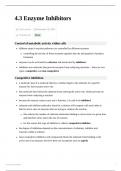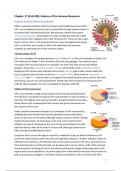Summary from Studeersnel
Tort:
● Most of the times not on purpose
● A wrong in civil
● Central question: ‘What is the duty of care’ (= very vague talking about facts
& circumstances
Universal Themes of Tort Law
1. Liability (aansprakelijkheid)
a. Wrongfulness = Failure to observe legal norms, either statutory or
unwritten norms.
i. “Reasonable and circumspect person”
ii. “Duty of care”
b. No fault-liability
i. Liability for conduct (gedrag) of others = Liability for harm
caused by employees/children.
ii. Liability not based on conduct
1. “How to morally justify liability without fault?”
2. Causation
a. Physical causation = about establishing a causal link
i. Operation of the conditio sine qua non (‘but for’) test.
ii. Liability for harm caused by employees or children.
b. Remoteness (afstandelijkheid) = about limiting the scope of the ‘but for’
test.
i. Uncorrected ‘but for’ tests lead to ‘Adam and Eve liability’.
ii. Test for remoteness is normative in nature.
iii. ‘foreseeability’ is key: is the damage too remote from the tort?
3. Remedies
a. Money: compare the actual financial position of the claimant to the
position he had been in without the tort
b. Injunction (rechterlijk bevel) = Order to do or not do something
c. Apologies
Some important lessons:
● Tort law is a verb. It is all (well, 80%) about identifying and weighing the facts
of the case! Alter one fact and the entire judgement may change.
● Do not let your natural ability to think about torts be distorted by intimidatingly
thick doctrinal books. Those books never provide an answer to the specific
case you are dealing with.
● Any tort law judgement can be explained to a reasonably intelligent
non-lawyer
Universal themes of criminal law
Crime = conduct that is defined as criminally punishable by the legislator
, ● A social construct, dynamic and changing over time and place
○ #MeToo case: Tom claiming that John slandered him, the status of
‘libel’ in law
○ So how do we decide what conduct should be a crime?
2 core characteristics of a ‘crime’
1. Conduct that ‘wrongs society as a whole’, violates public interests
a. State (public prosecution service) prosecutes crimes
b. ‘Public wrongs’ (crimes) vs ‘private wrongs’ (torts)
2. A crime is subject to ‘punishment’, as an expression of societal condemnation
a. Imprisonment (custodial punishment)
b. A fine (non-custodial punishment)
c. Retribution (crime) vs compensation (tort)
Principles of criminalization
- Justifying what conduct should be a crime
● The principle of individual autonomy
○ People are free to conduct their lives as they choose with as few
restrictions as possible
○ Therefore: any restriction on our right to govern ourselves and freely
choose how to act must be justified
● Principles of criminalization: they ‘seek to legitimate the use of criminal law by
providing a rational basis for the decision as to which conduct ought to be
punished’
○ 3 core principles: individual autonomy + harm + wrong
These principles can be systemized into an assessment framework
● Justifying principles
● Moderating (limiting) principles
● An argumentative (not absolute) framework for determining whether a given
conduct should be criminalized
, Justifying criminalization
The harm principle
● Interfering with an individual’s autonomy only allowed to prevent harm to other
individuals
○ Harm: an impairment to personal or proprietary resources of an
individual
■ Excluding harm to emotions or moral (offensive conduct)
● Harmful conduct v. conduct that is likely to produce harm
○ The more likely a conduct is to cause harm, the more likely its
criminalization
The principle of welfare (extending the notion of ‘harm’)
● Does ‘harm’ have to be limited to other individuals?
○ Humans as social creatures; need to protect certain societal
interests
● Protecting collective/public goods from harm
○ “individual autonomy [also] needs to be balanced against the
[…] state’s duty to create and maintain the social conditions that
allows the exercise and flourishing of autonomy”
● Public safety and security, public order, environment, etc.
The principle of ‘wrong’
● Aside from harmful, conduct must also be ‘wrongful’ to justify criminalization
● ‘Wrongfulness; : society considers the conduct to be morally reprehensible
(moral wrongfulness) or violating the rights of other (legal wrongfulness)
○ Moral or judicial element: conduct is wrongful if it warrants moral
condemnation or violates individual’s rights
○ Public element: the wrongful conduct is of concern to society as a
whole
○ Intuitive, subjective considerations that are easy to establish for primal
evils (eg. murder and rape) but difficult for many other activities (eg.
abortion and prostitution)
Conclusion: conduct must be ‘harmful’ and ‘criminal’ to be criminalised
However:
● There are still exception where only ‘harmful’ or only ‘wrongful’ conduct is
criminalised (eg. polygamy, adultery or possession a firearm without permit)
● Even if conduct is both ‘harmful’ and ‘wrongful’ this is not conclusive for its
criminalization (limiting principles)
Limiting principles against criminalization
1. Proportionality
a. Prospective proportionality: are the harm and wrong in said conduct
severe enough to warrant criminalization of that conduct
i. Classification offences in degrees of seriousness: crime/felony
vs misdemeanour
Tort:
● Most of the times not on purpose
● A wrong in civil
● Central question: ‘What is the duty of care’ (= very vague talking about facts
& circumstances
Universal Themes of Tort Law
1. Liability (aansprakelijkheid)
a. Wrongfulness = Failure to observe legal norms, either statutory or
unwritten norms.
i. “Reasonable and circumspect person”
ii. “Duty of care”
b. No fault-liability
i. Liability for conduct (gedrag) of others = Liability for harm
caused by employees/children.
ii. Liability not based on conduct
1. “How to morally justify liability without fault?”
2. Causation
a. Physical causation = about establishing a causal link
i. Operation of the conditio sine qua non (‘but for’) test.
ii. Liability for harm caused by employees or children.
b. Remoteness (afstandelijkheid) = about limiting the scope of the ‘but for’
test.
i. Uncorrected ‘but for’ tests lead to ‘Adam and Eve liability’.
ii. Test for remoteness is normative in nature.
iii. ‘foreseeability’ is key: is the damage too remote from the tort?
3. Remedies
a. Money: compare the actual financial position of the claimant to the
position he had been in without the tort
b. Injunction (rechterlijk bevel) = Order to do or not do something
c. Apologies
Some important lessons:
● Tort law is a verb. It is all (well, 80%) about identifying and weighing the facts
of the case! Alter one fact and the entire judgement may change.
● Do not let your natural ability to think about torts be distorted by intimidatingly
thick doctrinal books. Those books never provide an answer to the specific
case you are dealing with.
● Any tort law judgement can be explained to a reasonably intelligent
non-lawyer
Universal themes of criminal law
Crime = conduct that is defined as criminally punishable by the legislator
, ● A social construct, dynamic and changing over time and place
○ #MeToo case: Tom claiming that John slandered him, the status of
‘libel’ in law
○ So how do we decide what conduct should be a crime?
2 core characteristics of a ‘crime’
1. Conduct that ‘wrongs society as a whole’, violates public interests
a. State (public prosecution service) prosecutes crimes
b. ‘Public wrongs’ (crimes) vs ‘private wrongs’ (torts)
2. A crime is subject to ‘punishment’, as an expression of societal condemnation
a. Imprisonment (custodial punishment)
b. A fine (non-custodial punishment)
c. Retribution (crime) vs compensation (tort)
Principles of criminalization
- Justifying what conduct should be a crime
● The principle of individual autonomy
○ People are free to conduct their lives as they choose with as few
restrictions as possible
○ Therefore: any restriction on our right to govern ourselves and freely
choose how to act must be justified
● Principles of criminalization: they ‘seek to legitimate the use of criminal law by
providing a rational basis for the decision as to which conduct ought to be
punished’
○ 3 core principles: individual autonomy + harm + wrong
These principles can be systemized into an assessment framework
● Justifying principles
● Moderating (limiting) principles
● An argumentative (not absolute) framework for determining whether a given
conduct should be criminalized
, Justifying criminalization
The harm principle
● Interfering with an individual’s autonomy only allowed to prevent harm to other
individuals
○ Harm: an impairment to personal or proprietary resources of an
individual
■ Excluding harm to emotions or moral (offensive conduct)
● Harmful conduct v. conduct that is likely to produce harm
○ The more likely a conduct is to cause harm, the more likely its
criminalization
The principle of welfare (extending the notion of ‘harm’)
● Does ‘harm’ have to be limited to other individuals?
○ Humans as social creatures; need to protect certain societal
interests
● Protecting collective/public goods from harm
○ “individual autonomy [also] needs to be balanced against the
[…] state’s duty to create and maintain the social conditions that
allows the exercise and flourishing of autonomy”
● Public safety and security, public order, environment, etc.
The principle of ‘wrong’
● Aside from harmful, conduct must also be ‘wrongful’ to justify criminalization
● ‘Wrongfulness; : society considers the conduct to be morally reprehensible
(moral wrongfulness) or violating the rights of other (legal wrongfulness)
○ Moral or judicial element: conduct is wrongful if it warrants moral
condemnation or violates individual’s rights
○ Public element: the wrongful conduct is of concern to society as a
whole
○ Intuitive, subjective considerations that are easy to establish for primal
evils (eg. murder and rape) but difficult for many other activities (eg.
abortion and prostitution)
Conclusion: conduct must be ‘harmful’ and ‘criminal’ to be criminalised
However:
● There are still exception where only ‘harmful’ or only ‘wrongful’ conduct is
criminalised (eg. polygamy, adultery or possession a firearm without permit)
● Even if conduct is both ‘harmful’ and ‘wrongful’ this is not conclusive for its
criminalization (limiting principles)
Limiting principles against criminalization
1. Proportionality
a. Prospective proportionality: are the harm and wrong in said conduct
severe enough to warrant criminalization of that conduct
i. Classification offences in degrees of seriousness: crime/felony
vs misdemeanour










